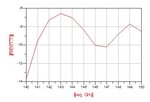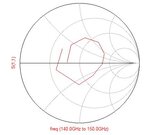shmily0447
Advanced Member level 4
Hi guys,
I have a trouble in matching the circuit. Can anyone kindly sugggest what I should do? Attached is the rectangular plot of the S11 and the S11 contour on smith chart.
Can anyone suggest that how I can shrink the contour of the S11 into the VSWR=2 circle in smith chart for a good matching?
It tortures me very much those days.


I have a trouble in matching the circuit. Can anyone kindly sugggest what I should do? Attached is the rectangular plot of the S11 and the S11 contour on smith chart.
Can anyone suggest that how I can shrink the contour of the S11 into the VSWR=2 circle in smith chart for a good matching?
It tortures me very much those days.


